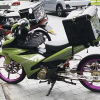Pilot project explores automatic parking payments using OBUs and ground-embedded sensors
Singapore drivers may soon say goodbye to fumbling for parking coupons or manually tapping through the Parking.sg app.
The Urban Redevelopment Authority (URA) has announced a new pilot project that aims to revolutionise roadside parking by introducing automated payments, one that is triggered the moment your car pulls into a spot.
This new system, if successfully rolled out, would use ground-embedded sensors that detect when a vehicle occupies or vacates a roadside parking space.
These sensors will then communicate with the vehicle’s on-board unit (OBU) via Bluetooth, automating the start and end of the parking session without any driver input.
How It Works
These thin, flat sensors are designed to be driven over without obstruction.
When a car enters the parking space, the sensor sends a Bluetooth signal to the OBU, which is the new in-car device being progressively installed across Singapore vehicles as part of ERP 2.0.
Unlike current parking methods, which rely on either the Parking.sg app or paper coupons, this pilot could completely remove the need for manual actions.
The goal? Frictionless, accurate, and transparent billing for time spent in roadside lots.
Where and When: The Pilot Rollout Plan
URA intends to run the pilot in two phases:
- Reliability Test
📍 Changi Beach Car Park 5
🗓️ Oct 2025 to July 2026
🛻 To be tested on: Sedans, lorries, prime movers, and buses (motorcycles excluded) - Operational Pilot
📍 Chinatown, Keong Saik, and Bukit Timah
🗓️ Aug 2026 to July 2027
🧭 Sites selected for ease of access and minimal disruption during trial
URA has clarified that there will be no automated payments triggered during the pilot period, as the test will focus on validating the accuracy and reliability of the system.
A Collaborative Effort with LTA
While this URA pilot is distinct, it runs parallel to ongoing efforts by the Land Transport Authority (LTA) to utilise the OBU for roadside parking in future.
LTA’s version will require motorists to manually initiate a session on their OBU’s touchscreen, which will automatically end once the vehicle departs.
Both agencies have confirmed they’ll work together to assess the pilot outcomes for possible future rollouts which is a sign that automated parking is not a question of if, but when.
What It Means for Drivers
If implemented successfully, this system could eliminate some of the most common frustrations motorists face with roadside parking, such as forgetting to start a session or overpaying for unused time.
Automated parking offers a more seamless experience, particularly in high-traffic or time-sensitive situations where every second counts.
With charges based precisely on the duration of the vehicle’s stay, billing becomes more accurate, reducing the chances of disputes or unnecessary payments.
At the same time, the need for enforcement may also decrease, as automated detection leaves less room for human error, potentially resulting in fewer fines for honest mistakes.
Beyond individual convenience, the system could also benefit city planners.
The data gathered from these sensors would offer deeper insights into parking demand and usage patterns, allowing agencies to better optimise roadside space allocation across Singapore.
That said, automation brings its own set of challenges.
Concerns may arise around data privacy, system reliability, and how short-term stops, such as quick deliveries or brief loading/unloading will be treated under an auto-charging model.
Striking the right balance between fairness and efficiency will be key as Singapore moves toward a smarter, tech-enabled parking future.
ERP 2.0: The Bigger Picture
The pilot is underpinned by the broader rollout of ERP 2.0, which is Singapore’s next-gen satellite-based road pricing system.
Over 500,000 vehicles have already been fitted with the new OBUs, which can handle location-based ERP charging, real-time alerts, and eventually, parking payments.
The OBU installation is expected to be completed by 2026, paving the way for mass adoption of features like automated parking payments.
What’s Next?
The URA tender for this project closes on August 21, with the selected vendor to be awarded by October 2025.
While the implementation timeline stretches over two years, the move signals a clear commitment toward modernising everyday driving experiences in Singapore.
With roadside parking still a daily routine for many.
From delivery drivers to families running errands, the promise of making it simpler, faster, and smarter is one worth watching closely.
Have a story to share?
Accidents occur frequently, but as responsible road users, we can collectively contribute to reducing their frequency.
If you or someone you know has a video or story to share, please do not hesitate to email us at writer@roads.sg
Together, we can all contribute to creating safer roads for everyone.
================
Get comprehensive cover at a lower price today! Receive up to S$400 worth of petrol vouchers with AIG. T&Cs apply. Protected up to specified limits by SDIC.
Get a quote now! www.aig.sg/roads








